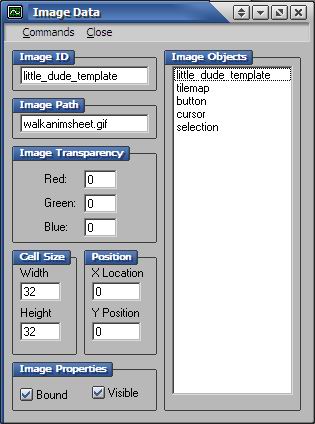
Image Objects
Here is where all the image objects are listed and by clicking on them you can display their properties for editing
Image ID
Here is where you define an image's ID. The object ID is the string used to reference the object in code. An ID can be anything but must follow these rules:
- IDs can have no spaces (underscores "_" are a good alternative)
- no two objects can have the same ID
Also, when an ID is edited here the changes are immediatly effective on its listing in the list box
Image Path
Here is where you set the path to the image so it can be loaded. Supported image types are BMP, PNM, XPM, LBM, PCX, GIF, JPEG, PNG and TGA.
Image Transparency
Each individual image can have its own transparency key, but it's generally easier to define a key to use on all images. Regardless, each image's transparency key must be individually set. The RGB value describes a color that will be ignored when an image is blitted onto the game surface, thus aloowing pixels undernteath to show through.
Cell Size
If the image object is a template of some sort then you must define the size of an individual cell. If the image is not a template, simply define the width and height as 0. Note that cells do not have to be square.
Position
This is the x and y position of the image (upper-left corner) on the screen
Image Properties
If you want an image to be seen you must check the Visible box. If you plan on using the image with another object (like a button or cursor) then check the Bound box otherwise uncheck it so that the image is rendered independantly.
| Prev: Application data |
Next:
Font data
|